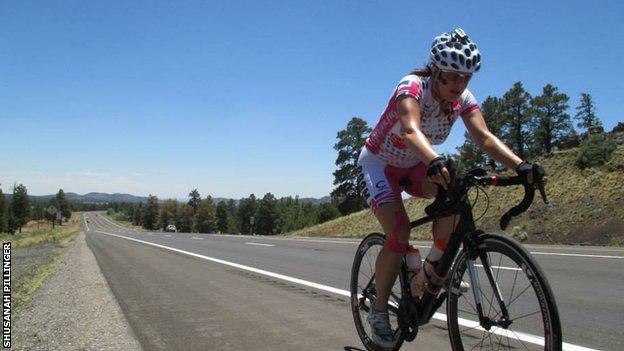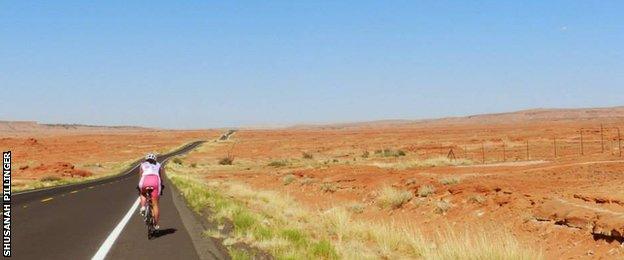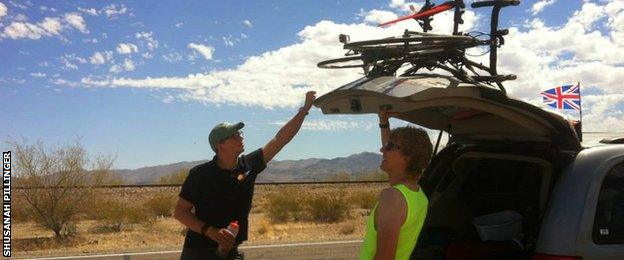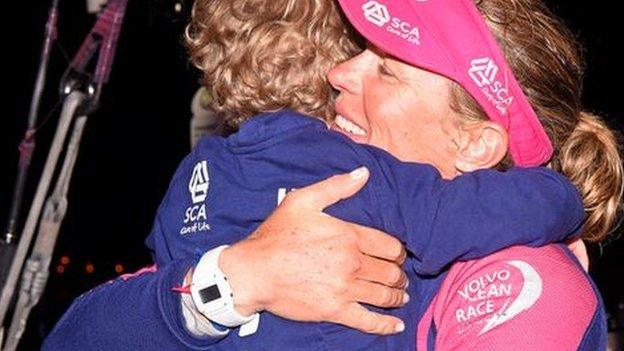Riding with your eyes closed: How to cycle 3,000 miles in 12 days
- Published

Shusanah Pillinger was in third place in the women's race at the time of her crash last year
Breaking a bone while sleeping is not exactly a common occurrence, but that comes with the territory when trying to cycle 3,000 miles across the United States in under 13 days.
Just ask ultra-cyclist Shusanah Pillinger, who while attempting to become the first solo British woman to complete the Race Across America last year, succumbed to severe sleep deprivation on her bike and broke her collarbone.
"I can assure you it's not possible to cycle while you sleep," she told BBC Radio Cambridgeshire as she prepares to try again in 2015.
You might ask why someone averaging just two hours' sleep per night would continue, but every second off the bike counts in "the world's most gruelling cycle race".
And the stats back that up.
To complete the women's solo race this year within the allowed 12 days and 21 hours, competitors need to average around 232 miles per day, the equivalent of cycling from Truro to London.
"On its own, 232 miles is OK," said Pillinger. "But try doing it for 12 days straight."
A pioneering family |
|---|
Shusanah Pillinger is the daughter of the late Colin Pillinger, the famed British planetary scientist best known for his 2003 attempt to land the Beagle-2 probe on Mars. |
Why, then, would anyone even think about attempting something like this? For Pillinger, it is about being first.
Only 273 people have ever completed the race solo since its inception in 1982 - 35 of the finishers were women and none have been British females.
Gloucester's Ann Wooldridge came close in 2009 when she reached the end of the course, but injury meant she finished a day over the time limit.
"There aren't many things you can be first at these days, and when I found out that no British woman had completed this solo before, it got stuck in my head," said Pillinger.
"The more I looked into it, the more I realised it was possible."
What is the Race Across America? |
|---|
First run in 1982 when four cyclists raced from the Santa Monica Pier in Los Angeles to the Empire State Building in New York. |
Now open to solo riders and relay teams of two, four and eight people. |
No requirement to be a professional cyclist. |
This year's race begins in Oceanside, California and finishes in Annapolis, Maryland, taking in over 175,000ft of climbs. |
So how does someone who works in IT in London train for the challenge?
"I don't sit on a train, I don't sit on a tube," she said. "I commute from St Albans to London, which is about 23 miles, but quite often I don't go in a straight line.
"I have done a five-counties route home before when I've left the office in London, been to Cambridgeshire and then home to Hertfordshire.
"You want to build up for it. It's like training for a marathon, you wouldn't run 26 miles in training."
Pillinger continued: "You're aiming for a certain distance that will give you an idea of what it's like to make sure your body can cope with it.
"You'd be expecting to do multi-day events, so I decided to do a race around Ireland, which is a five-and-a-half-day race.

Pillinger had completed 2,000 miles before her crash last year
"You want to make sure you're confident you can do the distance. But once you get to those distances it's a matter of just turning the legs over."
Despite her being classed as a solo rider, a team of eight are in close pursuit providing her with all she needs, from fresh clothes and ice vests to "banter" provision.
"A solo rider just cycles. [My crew] make the decisions for me," Pillinger added.
"We already have strategies of when I need food and drink, and clothing changes and sleep etc. They will try to keep to those and make sure I'm eating and drinking the right amounts. You can't get behind on that because there can be dire consequences."
The thought of 3,000 miles of open road ahead would fill most people with dread, but for Pillinger, absurdly, this is the least of her worries.
"It might surprise people that cycling isn't the hardest part of this," said Pillinger. "Cycling 3,000 miles is just getting on your bike and pedalling. But the logistics of this is an incredible challenge.
Record breakers |
|---|
The fastest solo rider to complete the course was Austria's Christoph Strasser, completing the 3,020-mile course in seven days, 15 hours and 56 minutes in 2014. |
The quickest woman is USA rider Seana Hogan, who finished the 2,912-mile course in nine days, four hours and two minutes in 1995. |
"I've got to take a team of eight people. I've got three cars including an RV. I've got three bikes including all the spares. We've got to label all the cars up. I've got to get clothing to deal with any possible weather I might experience.
"For cycling in Britain you need a rain jacket but out in the States last year there was one 24-hour section where the average temperature was 37 degrees.
"So I need ice vests, and when I need it, it can come from the vans behind me. There's a huge amount of energy bars and gels, and of course real food. We also have radio communication between me and the vans."
With so much to think about, it would be understandable for most people to give up before it even starts.
But for Pillinger, riding in aid of Hertfordshire Air Ambulance,, external it is about finding moments of joy among the madness.

Members of Pillinger's team during last year's race
"What keeps me going? I've got a team of eight amazing people, and we have a lot of fun.
"We have three following me at any time, there's a lot of banter that goes on. We've got an external PA system through which they can talk to me, and it's got a foghorn and can play music. We plan on blaring out music through the deserts.
"Each crew member is bringing their own playlists too so that we can mix it up."
And after setting off on 16 June, what sort of music will she be playing for all to hear?
"Mine currently has quite a lot of 90s club classics with a smattering of Eurovision - to educate the Americans."
- Published11 June 2015

- Published11 June 2015

- Published11 June 2015

- Published25 July 2019

- Published19 July 2016
